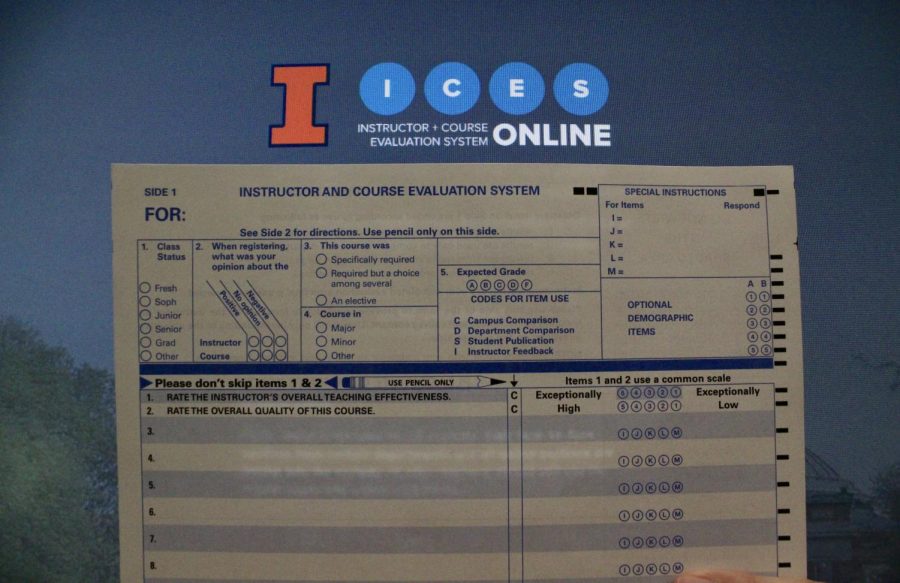ICES forms provide insight for teacher rankings on campus
A standard hard copy of a course evaluation form provided by Eric Keely, assistant director of measurement and evaluation at the Center for Innovation in Teaching & Learning, and Rajat Chadha, measurement specialist at CITL, in the Armory on Thursday.
October 29, 2018
It is nearing the time of year in which students at the University register for a new schedule of courses with new professors.
Every semester, the Center for Innovation in Teaching & Learning publishes a list of educators at the University who have been ranked as outstanding. These ratings are based on ICES forms turned in by former students at the end of the semester.
The University’s ICES forms are the teacher evaluations handed out to students at the end of each semester. For students, this is their primary opportunity to be open and honest about their experiences with instructors.
According to Rajat Chadha, measurement specialist at the CITL, the ICES forms’ primary purpose is for the use of professors, not necessarily students.
“The student ratings of instructors usually have two major purposes,” Chadha said. “The first is to get feedback from students to help improve their teaching. The second purpose is that those are used for promotional decisions and teaching awards on campus from each department.”
Get The Daily Illini in your inbox!
Professors can use these ratings as a baseline of performance improvement. And for those professors rated as outstanding, it serves as a recognition of performance that can be used for future jobs or awards.
According to Eric Keeley, assistant director of management and evaluation at the CITL, the outstanding instructors list serves as a sort of honor roll for educators.
“Students can use the list of teachers ranked as excellent to help select their courses,” Keeley said. “We have some teachers ranked as excellent for 15-20 years now.”
Keeley also went on to explain that ICES forms and outstanding professors list will benefit students by educators using these evaluations to change their performance.
The outstanding instructors list serves as recognition for instructors’ performances, but it is unclear whether or not it can be relied on to motivate teachers to improve their performance.
Avital Livny, assistant professor of political science and outstandingly ranked instructor, said she seldom uses the ICES forms to gauge her performance in class and instead has her own system of measuring her classroom dynamics.
“I issue a midterm evaluation in all of my classes,” Livny said. “I always really ask students to give me reasons why they do or don’t like what is happening, so it gives me more time to respond to their ratings.”
Livny feels the ICES forms come too late in the semester and don’t offer the best opportunity to implement changes.
“ICES forms come at the end of the year, and so by that point, it’s hard to implement changes for the next semester because it’s an entirely new group of students,” Livny said.
Juliana Reyes, sophomore in LAS, said she has never heard of the outstanding professors list, but she believes having that information could be very useful to students.
“I try to look online at websites such as Rate My Professors, but I didn’t know that the University publishes its list,” Reyes said. “I think it could be beneficial, but it also seems like just a courtesy thing.”
Reyes said she would want to know if professors were found to be outstanding by students or if students struggled with them.
“If I felt that I was struggling with a professor, I would automatically assume that it was my fault because I had no prior knowledge that other students may have struggled as well,” Reyes said.
Reyes agrees that the evaluations come too late and are often issued too late in a class period for students to have the opportunity to fill them out accurately.
Livny said while ICES forms are important, instructors should be motivated to use their own methods of self-evaluation.
“There is value in having a consistent evaluation system across the entire system,” Livny said. “I don’t think the current system is perfect, and I would encourage faculty to use midterm reports so that they can improve their teaching effectiveness in that same semester.”







